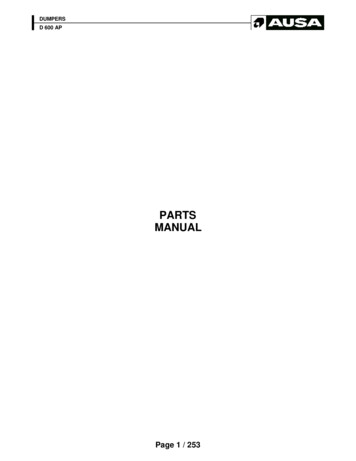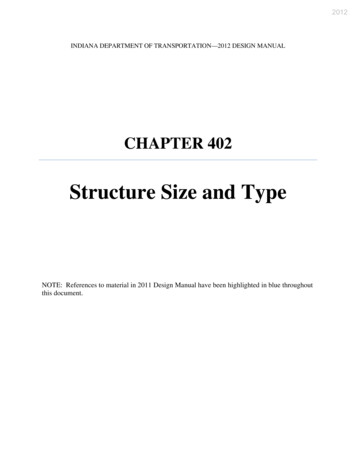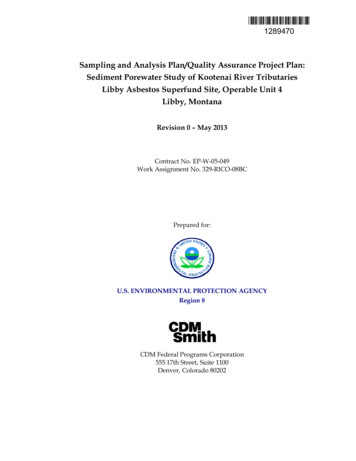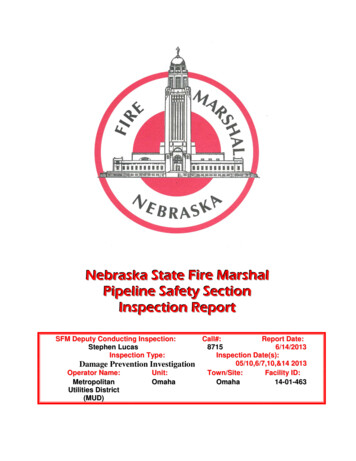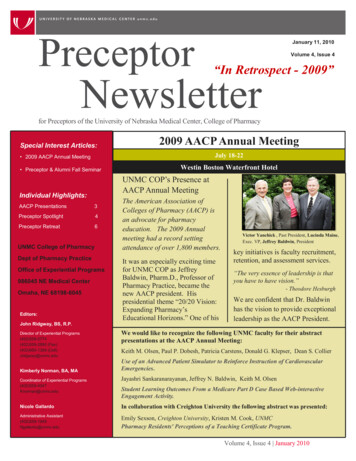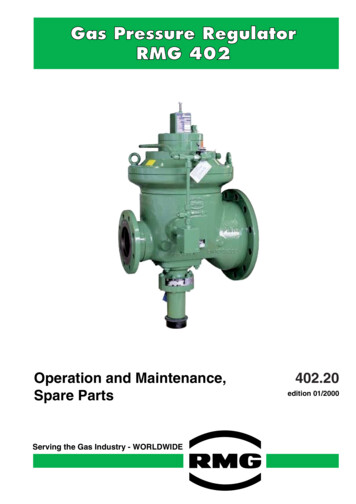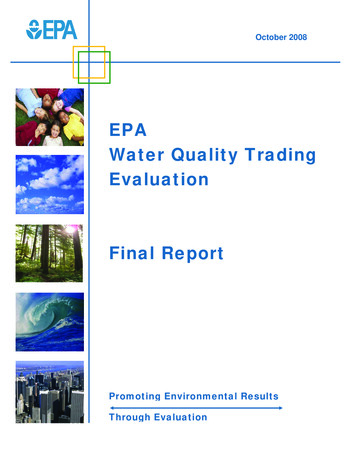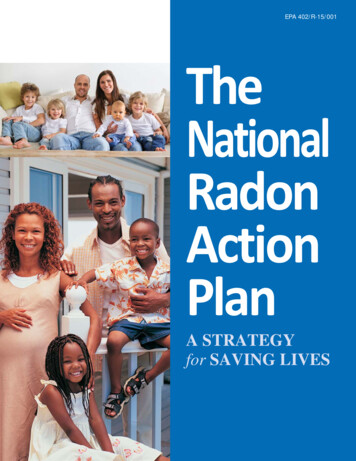
Transcription
EPA 402/R-15/001TheNationalRadonActionPlanA STRATEGYfor SAVING LIVES
A fresh focus on addressing theradon problem in our countrymust begin today. You canmake that happen.More than 21,000 liveslost each year to thispreventable disease is nolonger acceptable.We can’t do it alone. We areliterally dying. We need yourhelp to save lives.Elizabeth HoffmannCo-founder and President of Cancer Survivors Against Radon (CanSAR)From her testimony before the U.S. Congress on March 21, 2012Ms. Hoffmann passed away on November 6, 2013, after a multiyearbattle against lung cancer.
TheNationalRadonActionPlanA STRATEGYfor SAVING LIVESDeveloped Through the Collaborative Efforts ofAmerican Lung AssociationAmerican Association of Radon Scientists and TechnologistsAmerican Society of Home InspectorsCancer Survivors Against RadonChildren’s Environmental Health NetworkCitizens for Radioactive Radon ReductionConference of Radiation Control Program DirectorsEnvironmental Law InstituteNational Center for Healthy HousingU.S. Environmental Protection AgencyU.S. Department of Health and Human ServicesU.S. Department of Housing and Urban DevelopmentThe National Radon Action Plan1
Our VisionThe National Radon Action Plan presents a long-rangestrategy for eliminating avoidable radon-induced lung cancer in the United States.The Plan’s near-term goals are to reduce radon risk in5 million homes and to save 3,200 lives by 2020. Whilethe 2020 goals offer bold and important milestones, theyare not the endpoint.Our ultimate goal is to eliminate avoidable radon-inducedlung cancer in the United States by incorporating radontesting, radon mitigation and radon-resistant constructioninto the systems that govern purchasing, financing, constructing and renovating homes and other buildings. Usingsimple and proven technologies, we can eliminate avoidable radon-induced lung cancers. We need to apply thosetechnologies as standard practice and we will, over time,reduce radon risk across the U.S. building stock. When wefind, fix and prevent high indoor radon levels as a standardpractice so that no American is exposed to avoidable radonat home, school or work, we will have achieved the vision ofthis Plan.Our Foundationfor SuccessStarting with Federal ActionIn 2010, the situation that more Americans may be at riskfrom radon than ever before, despite years of government,non-government and industry effort to address radon, lednine federal agencies to look for new solutions.1 They cametogether to develop the Federal Radon Action Plan2 andto launch more than 30 new projects that promote radonaction through three approaches: Testing for and mitigating high radon usingprofessional radon services. Providing financial incentives and direct supportwhere needed for radon risk reduction.Radon causes 21,000 lung cancer deaths everyyear, even though we know how to find, fix andprevent it. Many radon-induced lung cancer deathsare preventable.Testing for and mitigating high radon levels usestested, time-proven, straightforward techniques.Our vision is to make radon risk reduction standardpractice to eliminate avoidable radon-induced lungcancer in the United States. Demonstrating the importance, feasibility and valueof radon risk reduction.The National Radon Action Plan2
The Federal Radon Action Plan established a strong foundation for future success. Key federal agencies initiatedpolicies to begin to find, fix and prevent high radon levelsin government-influenced buildings. Those actions aresaving lives and will continue to do so into the future. As of2014, federal actions have already reached an estimated1.6 million homes, schools and childcare facilities withguidance and incentives to reduce radon risk and havetested for and mitigated high radon risk when necessary innearly 200,000 units.3The Federal Radon Action Plan also signaled to thenon-governmental sector a renewed seriousness and commitment to reducing radon risk and finding new tools tosupport a comprehensive approach. In response, in 2013,twelve leaders from national organizations representing government, nonprofit and industry joined together to expandthe effort to eliminate avoidable radon-induced lung cancer.4Moving to National ActionThe American Lung Association led a national radon workgroup to develop this Plan. Our workgroup’s purpose is tobuild upon, leverage and accelerate the impact of the federal plan and to advance coordinated national action. Weknow that no single approach will solve the radon problem.Our job is to identify proven effective policies, techniquesand strategies for reducing radon risk and to gather thepeople, organizations and resources required from government, non-government and industry organizations to putthose strategies into action. We recognize the critical importance of supporting strong and effective state and tribalradon programs that can engage with and support otherpartners to implement this Plan.Our group met throughout 2014 to discuss how to movequickly toward a future where all homes are tested forradon, all high-radon homes are mitigated, and all newhomes are built to prevent high radon levels. We saw valuein the Federal Plan’s framework for radon action, which focused on demonstrating radon’s significance, providing incentives and support, and building demand for professionalradon services. We believe, however, that the essentialdriver of transformational change for radon is missing.“Building in” is our term to describe strategies that cansolve the U.S. radon problem. Approaches that embed radon testing, mitigation and radon-resistant construction as3The National Radon Action Plannorms of individual behavior, industry practice and publicpolicy build in radon risk reduction so that it occurs as amatter of course.We refined the framework for planning action that the federal government had started with to include the following(as shown in the figure on page 5): Build in radon risk reduction: Approaches that embedradon risk reduction as standard practice across theentire housing sector. Provide incentives and support for radon riskreduction: Approaches that motivate individualsto pay for testing, mitigation and radon-resistantconstruction with financial encouragement andprovide direct financial support for radon testing andrisk reduction for people who cannot pay. Test and mitigate using professional radon services:Approaches that promote the use of certified radonservices and help to build demand to sustain a highquality industry. Increase visibility: Approaches that garner broadpublic attention for the radon issue and demonstratethe importance of radon risk reduction.The federal workgroup recognized that its workalone would not dramatically reduce radondeaths. The federal plan was always intended tobe a starting point and a catalyst for a broadernational effort.
We believe that an effective plan will pursue all fourstreams of work while prioritizing approaches and policiesthat build in radon risk reduction. Early federal actiongenerated baseline progress by incentivizing radon action,testing for and mitigating high radon levels, and increasing visibility of the radon issue. In the next phase, we willfocus on building in radon risk reduction to drive mitigationfar to define a strategy for the future and lays the groundwork for implementing the National Radon Action Plan. Wealso have started to identify leaders to spearhead individualapproaches and have developed our capacity to collaborateacross organizations to implement this plan.In the next year, our workgroup will undertake the following:in 5 million high-radon units, save 3,200 lives by 2020,and set the United States on a path to eliminating avoidable lung cancer from radon. Consider new strategies and propose policies that arenot currently being pursued and evaluate their likelyeffectiveness for inclusion in the Priority Strategiesfor Saving Lives table.Using our four-stream framework for action planning andthe best available evidence, our workgroup evaluated the Review the Federal Radon Action Plan scorecard toidentify and coordinate with ongoing federal activitiesand identify potential areas for future joint action.effectiveness of various strategies for reducing radon risk.We examined strategies employed in the federal plan andhistorical radon efforts according to four criteria: Impact: A strategy’s direct effect on high indoorradon levels and the size of the population it willaffect. Level of effort: The amount of effort required topursue a strategy to the point of achieving impact. Feasibility: The likelihood that a strategy cansucceed, considering structural challenges, financialimplications and other factors. Measurability: Our ability to measure a strategy’simpact over time in terms of radon risk reduced.Using this model, we ranked priority strategies requiringaction. Table 1—National Radon Action Plan: PriorityStrategies for Saving Lives—contains the strategies weplan to pursue and the outcomes each stream of work isintended to achieve. It summarizes our group’s work thus Identify priority strategies and the steps we need totake to achieve the envisioned results. Identify the individuals, organizations and expertisewe need to bring to this work to meet our objectives. Determine how to pursue individual strategies withpeople best suited to the work, while also workingacross teams to coordinate a unified effort. Develop milestone targets and meaningful measureswe can use to track progress on individual strategiesand the National Radon Action Plan as a whole. Create a publicly visible tracking tool to report on ourprogress and keep this effort on track.The vision and strategy presented here will guide ourefforts.To learn more about the National Radon Action Plan andto join our national effort to eliminate avoidable lungcancers from radon, please contact Radon@epa.gov.The National Radon Action Plan4
NATIONAL STRATEGY FOR PREVENTING RADON-INDUCED LUNG CANCERA federal, non-profit, and private sector approach for achieving durable changes to the US housing stockFEDERAL ACTIONSTO SAVE LIVESUSDAIssued secretary-level guidancepromoting radon mitigation andradon-resistant new construction,potentially reaching 301,000 loanrecipients.20112014Launch Federal PlanFederal Actions Reach 1.6M homes,schools, and childcare facilities20152020Release National StrategyGoal – Mitigate 5 million units; Save 3,200 uraged more than 1.3 millionveterans receiving home loans to testtheir homes for radon.DOITested over 3,800 residential units,identified 158 units at risk, andGSATested all of its 103 federal50 additional federal buildings.EPAInvested in 4 new standards ofpractice for testing and fixing radonin schools, daycares, and multifamilyhousing, and quality assurance for labanalysis.HUDTested over 190,000 new and existing units for radon and mitigatedhigh radon where it was found.DODReviewed its Unified FacilityCriteria to ensure radonmeasurement, mitigation,and radon-resistant newconstruction for low-rise buildingsreflects current standards.DOEProvided health and safety training,including radon, to more than650 weatherization programadministrators.HHSIncreased to 35 states, 3 tribes and1 territory the number of five-yearcancer control plans that includeradon.FEDERAL ACTION PLANFederal Agencies Take New Action to Protect People and Families From RadonNATIONAL ACTION PLANFederal, non-profit and private sector leaders expand efforts to increaseradon risk reduction and save more lives.The National Radon Action Plan5
Table 1: National Radon Action Plan: Priority Strategies for Saving LivesWhat Needsto Happen1Build in RadonRisk Reduction2ProvideIncentives andSupport forRadon RiskReduction3Strategies to Drive ChangeWork with government, quasi-governmental andprivate sector housing finance organizations toencourage radon testing and mitigation as a standardpractice.Housing finance and insurance industries takeactions that will increase radon testing andmitigation in homes.Embed radon risk-reduction requirements in stateand local building codes.State and local building codes require that homes bebuilt to resist radon.Develop the research base on the cost-effectivenessof preventive and mitigation actions for radon inenergy upgrades.Energy upgrades include radon risk reduction asstandard practice where needed.Ensure radon is a priority risk addressed in healthyhomes programs and grant-making.Criteria for national programs promoting healthyhomes include radon risk reduction.Leverage government-backed and other housingloans to cover radon mitigation.New sources of funding are available to motivatehomeowners to test for and mitigate high radonlevels.Secure direct support from philanthropies, charitiesand other sources, including governments, to reduceradon risk for low-income Americans in homes,schools and childcare centers.Radon mitigation is financed in buildings where theoccupants are unable to afford testing and mitigationon their own.Leverage tax incentives, including health spendingaccounts, to cover radon mitigation costs in order toreduce cancer-related healthcare costs.Tax incentives exist that increase voluntary radontesting and mitigation.Finalize and disseminate consensus standards fortesting, mitigating and ensuring measurement deviceaccuracy.Quality professional standards to support the certifiedradon services industry are widely recognized,disseminated and adopted.Build Capacity Provide training on high-quality radon testing andto Test andmitigation in home health and safety training.Mitigate UsingProfessionalPromote the radon profession to practitioners, suchRadon Servicesas home inspectors.Promote radon testing and mitigation through acomprehensive disclosure of health risk to homebuyers and loan borrowers.4IncreaseVisibility forRadon IssueOutcomes We SeekHome health and safety training programs for inhome service practitioners routinely include radon.More certified radon professionals are availablenationwide.State and local laws require that sellers discloseknowledge of radon levels and information aboutradon to prospective buyers.During property sales, borrowers request testing andmitigation where needed to reduce radon risk.Encourage state cancer control plans to prioritizeradon.State cancer plans include strategies for reducingradon.Focus on radon in coordinated messaging abouthealth risks in homes, schools and childcare centers.Increased amount, coordination and effectivenessof communication tells Americans that radon is aserious risk that needs to be a priority for action.Promote radon awareness to medical, public healthand childcare communities through consistentoutreach using targeted materials.Medical, public health and childcare practitionerseducate patients and families about radon duringroutine encounters and increase their actions toreduce radon in home and childcare environments.The National Radon Action Plan6
Endnotes1Because of recent housing construction booms and insufficient voluntary radon action, more U.S. homes wereat risk in 2010 than had been estimated to be at risk in1986, when EPA last conducted a nationwide radon riskassessment.2The membership of the Federal Radon Action Plan Workgroup included representatives from the U.S. Departmentof Agriculture, U.S. Department of Defense, U.S. Department of Energy, U.S. Department of Health and HumanServices, U.S. Department of Housing and Urban Development, U.S. Department of the Interior, U.S. Departmentimplementation. Actions include testing and/or mitigation,distributing home loans that include a radon educationcomponent, and reaching homes/units through grantof Veterans Affairs, U.S. Environmental Protection Agency,and the U.S. General Services Administration. The 33commitments to radon action that they made in 2010 aredescribed and tracked at on-plan-scorecard.3The Federal Radon Action Plan’s estimated reach isbased on actions taken by agencies as part of the Plan’s7The National Radon Action Planprograms.4The member organizations in the national stakeholdergroup that developed this Plan are listed at the top of thisdocument.
encourage radon testing and mitigation as a standard practice. Housing finance and insurance industries take actions that will increase radon testing and mitigation in homes. Embed radon risk-reduction requirements in state and local building codes. State and local building codes require that homes be built to resist radon.

